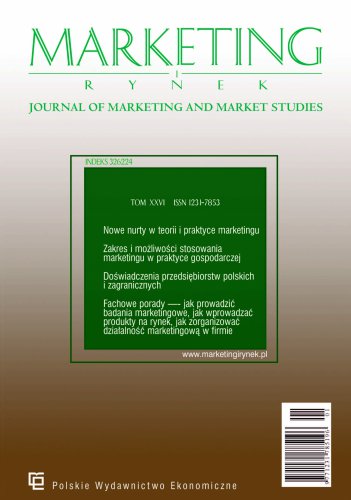Subliminal advertising as a tool of persuasion in marketing communication
For many years, subliminal advertising has aroused a lot of controversy in the community of researchers dealing with this phenomenon. As it turned out that the results of the first study on the operation of subliminal advertising were probably falsified, there were doubts as to whether this form of advertising could be effective at all. A break through for this type of opinion was research on subliminal priming, which showed that the presentation of a subliminal stimulus can have an impact on the cognitive and affective system of a human. Over the past 20 years, an increase in interest in the effects of subliminal persuasion has been observed, which is reflected in the growing number of publications devoted to research on this phenomenon. It turns out that the effects of exposure to subliminal stimuli can be observed not only in relations to consumer behavior, but thanks to the methods used in research on the functioning of the brain, the action of such stimuli is also recorded at the level of changes in brain wave activity. The article reviews research on the effects of subliminal stimuli, the results of which can be used in marketing communication.
References
Bibliografia/References
Barchas, P. R. i Perlaki, K. M. (1986). Processing of preconsciously acquired information measured by hemispheric asymmetry and selection accuracy. Behavioral Neuroscience, 100. https://doi.org/10.1037/0735-7044.100.3.343
Beatty, S. i Hawkins, D. I. (1989). Subliminal stimulation: Some new data and interpretation. Journal of Advertising, 18. https://doi.org/10.1080/00913367.1989.10673156
Bornstein, R. F. (1989). Exposure and affect: Overview and meta-analysis of research, 1968–1987. Psychological Bulletin, 106. https://doi.org/10.1037/0033-2909.106.2.265
Bullock, A. (2008). Reklama podprogowa. Jak niepostrzeżenie wniknąć w umysł odbiorcy. Gliwice: Helion.
Cooper, J. i Cooper, G. (2002). Subliminal motivation: A story revisited. Journal of Applied Social Psychology, 32. https://doi.org/10.1111/j.1559-1816.2002.tb01860.x
Cuperfain, R. i Clarke, T. K. (1985). A new perspective on subliminal perception. Journal of Adertising, 14. https://doi.org/10.1080/00913367.1985.10672928
Dijksterjuis, A., Aaarts, H. i Smith, P. (2005). The power of the subliminal: On subliminal persuasion and other potential applications. W: R. R. Hassin, J. S. Uleman i J. A. Bargh (Red.), The New Unconscious. New York: Oxford University Press. https://doi.org/10.1093/acprof:oso/9780195307696.003.0005
Dixon, N. F. (1971). Subliminal perception: The nature of a controversy. McGraw-Hill.
Dixon, N. F. (1981). Preconscious processing. John Wiley & Sons.
Fennis, B. i Stroebe, W. (2010). The Psychology of Advertising. New York: Psychology Press. https://doi.org/10.4324/9780203853238
Greenwald, A. G. (1992). New Look 3: Unconscious cognition reclaimed. American Psychologist, 47. https://doi.org/10.1037/0003-066X.47.6.766
Heath, R. (2014). Uwieść podświadomość. Psychologia reklamy. Sopot: GWP.
Hsu, L. i Chen, Y-J. (2022). Neuromarketing, subliminal advertising, and hotel selection: An EEG study. Australasian Marketing Journal (w druku).
Karremans, J. C., Stroebe, W. i Claus, J. (2006). Beyond Vicary's fantasies: The impact of subliminal priming on brand choice. Journal of Experimental Social Psychology, 42. https://doi.org/10.1016/j.jesp.2005.12.002
Kunst-Wilson, W. R. i Zajonc, R. B. (1980). Affective discrimination of stimuli that cannot be recognized. Science, 207. https://doi.org/10.1126/science.7352271
Mandler, G., Nakamura, Y. i Van Zandt, B. J. S. (1987). Nonspecific effects of exposure on stimuli that cannot be recognized. Journal of Experimental Psychology: Memory, Learning, and Cognition, 13. https://doi.org/10.1037/0278-7393.13.4.646
Marcel, A. J. (1983). Conscious and unconscious perception: Experiments on visual masking and word recognition. Cognitive Psychology, 15. https://doi.org/10.1016/0010-0285(83)90009-9.
Merikle, P. M. i Reingold, E. M. (1992). Measuring Unconscious Perceptual Processes. W: R. F. Bornstein i T. S. Pittman (Red.), Perception without awareness: Cognitive, Clinical, and Social Perspective. New York: Guilford Publications.
Murphy, S. T. i Zajonc, R. B. (1988). Cognitive and affective priming with and virtually without awareness. Referat wygłoszony na 96 zjeździe Amerykańskiego Towarzystwa Psychologicznego. Atlanta.
Ohme, R. K. (Red.). (2007). Nieuświadomiony afekt. Najnowsze odkrycia. Gdańsk: GWP.
Packard, V. (1980). Hidden persuaders. New York: Washington Square Press.
Pratkanis, A. R. (1992). The cargo-cult science of subliminal perception. Skeptical Inquirer, 16.
Samuel, R. S. (2010). Freud on Madison Avenue. Motivation research and subliminal advertising in America. University of Pennsylvania Press. https://doi.org/10.9783/9780812204872
Smarandescu, L. i Shimp, T. A. (2014). Drink coca-cola, eat popcorn, and choose powerade: testing the limits of subliminal persuasion. Mark. Lett., 26(4). https://doi.org/10.1007/s11002-014-9294-1
Smith, G. J. W., Spence, D. P. i Klein, G. S. (1959). Subliminal effects of verbal stimuli. Journal of Abnormal Social Psychology, 59. https://doi.org/10.1037/h0043156
Strahan, E. J., Spencer, S. J. i Zanna, M. P. (2002). Subliminal priming and persuasion: Striking while the iron is hot. Journal of Experimental Psychology, 38. https://doi.org/10.1016/S0022-1031(02)00502-4
Zajonc, R. B. (1980) Feeling and thinking. Preferences need no inferences. American Psychologist, 35. https://doi.org/10.1037/0003-066X.35.2.151

